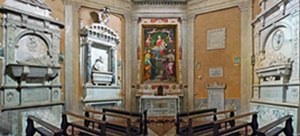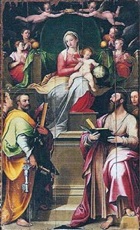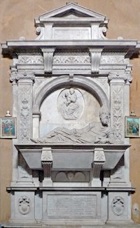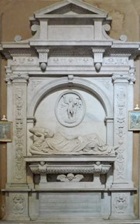


Monument to Farrattini Monument to
Bartolomeo II Farrattini Altarpiece Baldo Farrattini
This octagonal chapel (2nd on the right) contains the funerary monuments of three members of the Farrattini family. The epitaph of one of them, that of Baldo Farrattini (see below), records that he commissioned the chapel for his own tomb and that of his uncle, Bartolomeo II, who had predeceased him. This is likely to have been during his period as Bishop of Amelia, in 1558-62. He probably also commissioned the altarpiece for the chapel.
The design of the Farrattini Chapel was probably inspired by the Del Monte Chapel in San Pietro in Montorio, Rome (illustrated as the 4th picture in the link given here), which Pope Julius III had commissioned in 1550 specifically for the monuments of his uncle, Cardinal Antonio del Monte and his great-uncle, Fabiano del Monte. He appointed Giorgio Vasari to design and supervise the project, under the guidance of Michelangelo. Vasari had wanted to appoint Raffaello da Montelupo to sculpt the figures in the monuments, but he was over-ruled on the advice of Michelangelo, and the commission went to the young Bartolomeo Ammananati. Given his links (see below) with the young sculptors who worked in the Farrattini Chapel, it is possible that Raffaello da Montelupo had a hand in its design and in recommending his erstwhile pupils to Baldo Farrattini.
Mariano Guardabassi described the Farrattini Chapel in his guide of 1872:
-
✴An entrance arch opened onto a space with a chapel to each side, which is now the vestibule (described in the main page on the Duomo).
-
✴A second arch opened onto the “cappella di centro”, which contained:
-
•the present altarpiece, which Guardabassi attributed to Federico Zuccari (see below); and
-
•the two funerary monuments mentioned above:
-
-that of Bartolomeo II Farrattini (died 1534) on the left, which he attributed to Ippolito Scalza (see below); and
-
-that of Baldo Farrattini (died 1567) opposite, which was signed “Opus Hippoliti Scalzi de Urbeveteri” (the work of Ippolito Scalza of Orvieto).
More recent scholarship attributes the monument of Bartolomeo II Farrattini to Giovanni Antonio Dosio (see below). One of his sketchbooks (ca. 1559-65), which survives in the Staatsbibliothek, Berlin, contains a view of Amelia dated May 1564. It also contains a note of his itinerary in 1564: he left Orvieto in April for Amelia, where he stayed to work with Ippolito Scalza, before leaving for Rome in July.
Obviously, this chapel and the two monuments could not have been built in a few months in 1564, and a number of factors suggest that the project started in ca. 1560:
-
✴As noted above, Baldo probably initiated it during his period as Bishop of Amelia, in 1558-62: he relinquished this post thereafter because he was so busy in Rome.
-
✴Ippolito Scalza was documented in Amelia in 1562, and was otherwise absent from the records of the Opera del Duomo, Orvieto (his usual employer) from February 1561 until September 1564.
-
✴There is nothing in the known movements of Giovanni Antonio Dosio that would preclude repeated visits to Amelia during this period, in addition to the documented visit of 1564.
It is interesting to note that all of the artists involved with this project were just starting out in their careers in 1560, and all had links with Orvieto and with Raffaello da Montelupo (as mentioned above):
-
✴Federico Zuccari (aged about 20) was still working mostly under his older brother, Taddeo. He had accompanied Taddeo to Orvieto in 1558 to decorate a chapel in the Duomo (as part of a programme directed by Raffaello da Montelupo). The brothers left before the contracted work was completed, apparently due to illness but possibly to begin work for Cardinal Alessandro Farnese in the Sala dei Fasti of Villa Farnese, Caprarola. Federico’s earliest documented independent work dates to 1561-4.
-
✴Giovanni Antonio Dosio (aged 27) had trained in the workshop of Raffaello da Montelupo in Rome in 1548-51. His biographer asserts he scratched out a miserable living in the period thereafter, so a commission in Amelia in 1561 would have provided him with an important opportunity. As noted above, he visited Orvieto in 1564, en route for Amelia.
-
✴Ippolito Scalza (aged 28) was first documented in 1554, when he began his life-long employment by the Opera del Duomo of Orvieto under Raffaello da Montelupo. This work in Amelia was his first important independent commission.
While these connections must have played a part in the commissioning of these untried artists, it is also seems that Giovanni Antonio Dosio had direct links to Baldo Farrattini in Rome: his drawings mentioned above include some of the Roman sculptures in the house of Baldo Farrattini there.
Farrattini Altarpiece (ca. 1560)

As noted above, Mariano Guardabassi saw the altarpiece in its original position in 1872 and attributed it to Taddeo’s younger brother, Federico Zuccari. Modern scholarship tends to support this attribution.
The panel was transferred to Palazzo Farrattini in 1881 and sold in 1913. The Cassa di Risparmio di Terni e Narni bought it in 1990, financed its restoration in 1992, and returned it to its original location.
Funerary Monuments
Monument to Baldo Farrattini (1561-4)
In the monument, Baldo (who was still alive when the work was carried out) lies in effigy on top of the sarcophagus. His head is resting on his hand: he could be asleep but he could also be meditating on the image of the Risen Christ in the relief above him.
The monument is clearly inspired by the central section of the funerary monument of Cardinal Ascanio Sforza in the retro-choir of Santa Maria del Popolo, Rome, which Pope Julius II commissioned from Andrea Sansovino.
Monument of Bartolomeo II Farrattini (1561-4)

The monument is attributed to Giovanni Antonio Dosio, on the basis of the surviving documents discussed above and also on stylistic grounds. This attribution is supported by the fact that the figure of the Madonna and Child in relief above the effigy strongly resembles a sketch in the “Libro de’ Disegni” of Giogio Vasari, which is identified (presumably by Vasari) as the work of Giovanni Antonio Dosio.
In the monument, the deceased, who lies in effigy on top of the sarcophagus, is shown awake and gazing at the Farrattini Altarpiece (above), which contains an image of his name saint. This type of effigy was newly-fashionable: the version here is close to that on the monument (1548) to Bishop Bernardino Elvino by Guglielmo della Porta in Santa Maria del Popolo, Rome. (I have not been able to find a photograph).
Bust of Cardinal Bartolomeo III Farrattini (early 17th century)

Bartolomeo III had succeeded Baldo, his uncle, as Bishop of Amelia, resigning in 1571. He then moved to Rome, where he built Palazzo Farrattini in Piazza di Spagna. He was made a cardinal in 1606 but died before he could receive his red hat of office. A cardinal’s hat is depicted above the Farrattini arms in the aedicule that now contains his bust.


